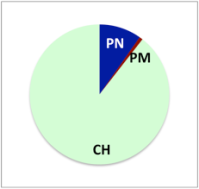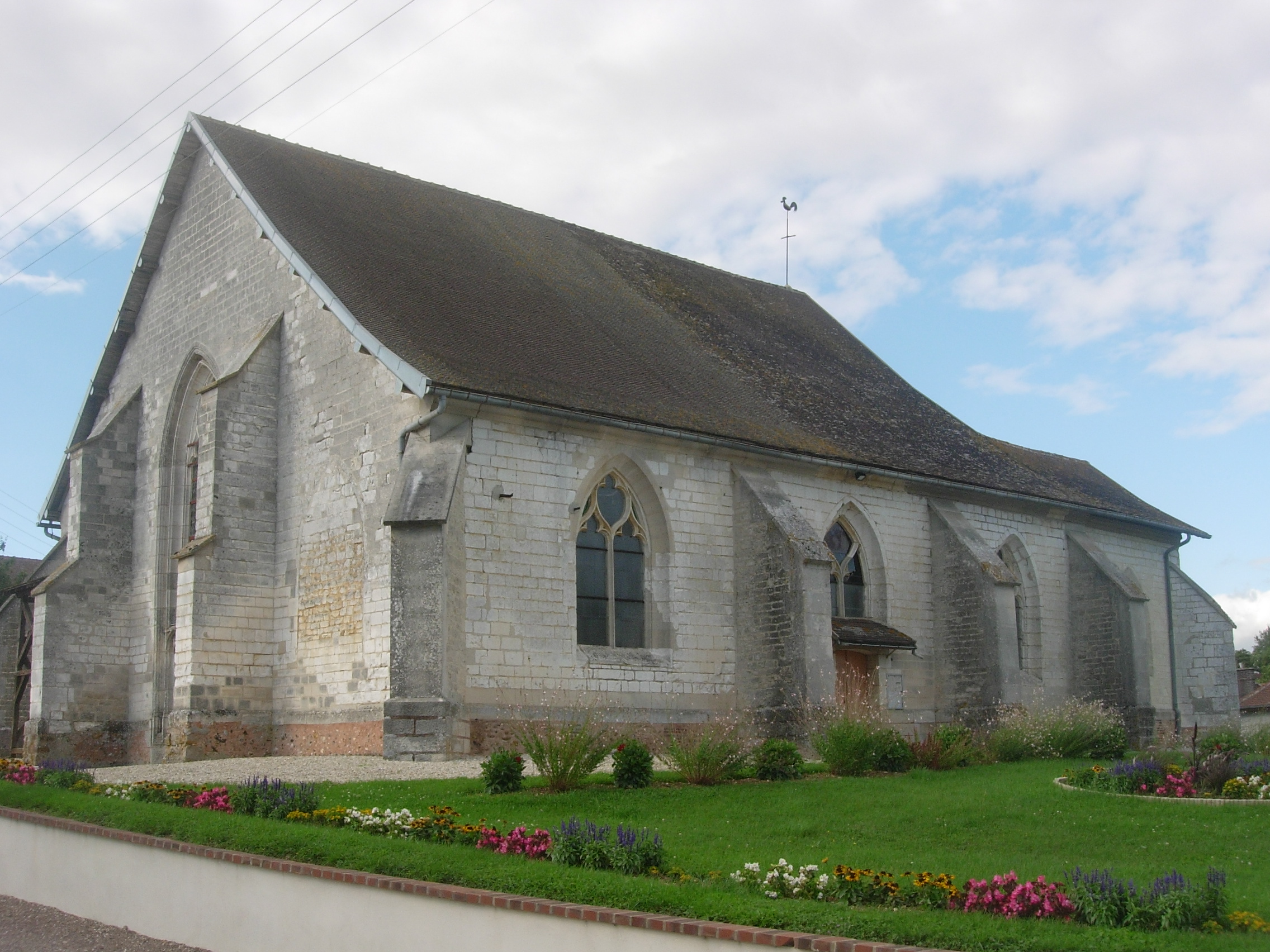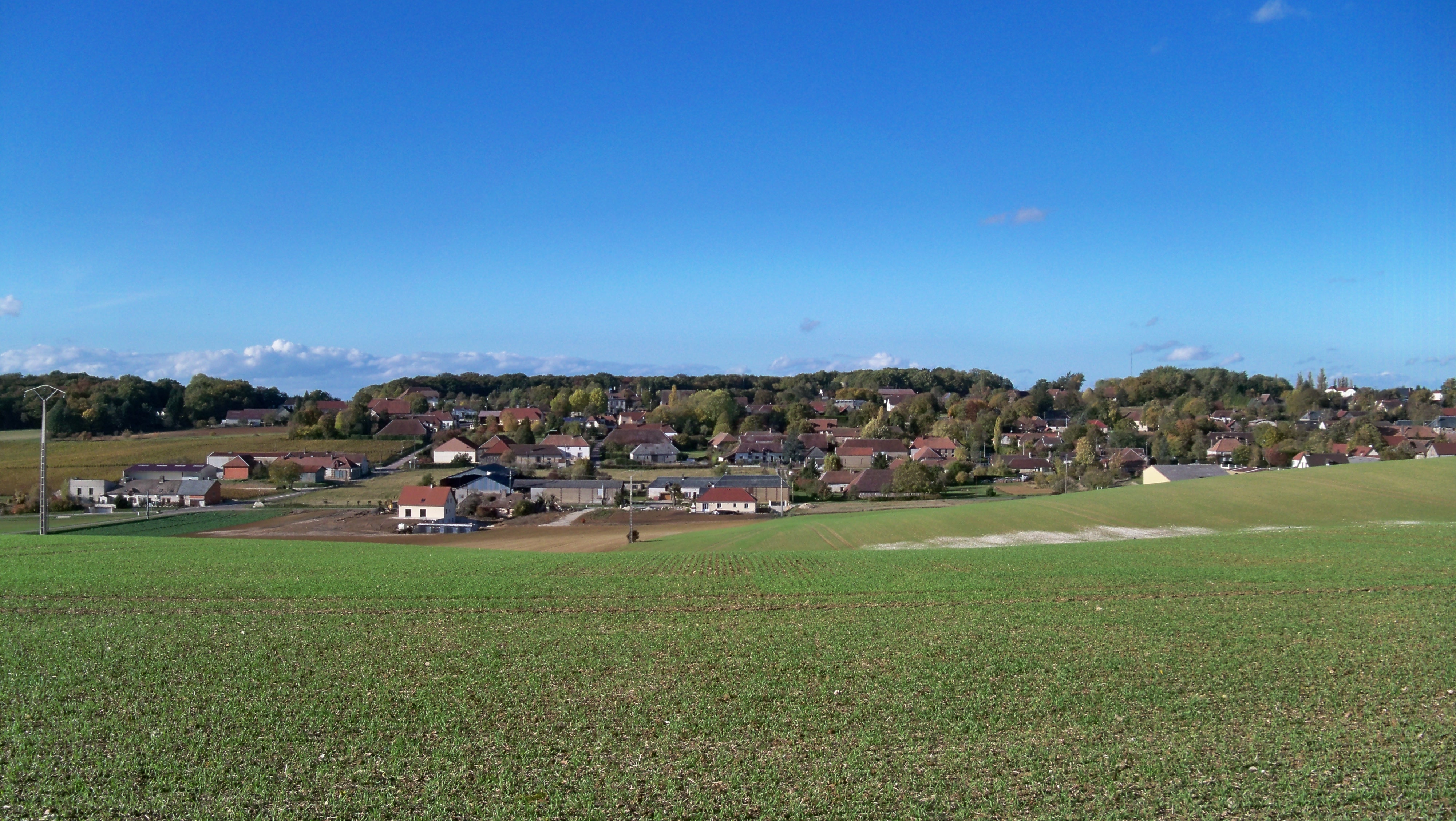 Key facts
Key facts
Located in subregion/area: Côte des Blancs / Montgueux
Vineyards and grape varieties: 208.2 ha (514.5 acres), of which 90% Chardonnay, 10% Pinot Noir, and 0.4% Pinot Meunier.
Classification: “Autre cru” (80%)
Noted for: good Chardonnay
Map

The map is linked from Wikimedia Commons, and the geographical information originates from OpenStreetMap. The dotted white area corresponds to the vineyards, light yellow is other open terrain, orange is built-up areas, and green indicates forest. Troyes is located just outside the map to the east.
Neighbouring villages
None of the communes that border to Montgueux are part of the Champagne appellation.
The village
Montgueux is located rather far to the south in the Champagne wine region, in the Aube departement. The village is situated a few kilometers west of the Troyes, the departemental capital with 60 000 inhabitants in the commune and 130 000 in Greater Troyes. It is by far is the largest city in this part of the region.
The Montgueux commune also includes the hamlet La Grange au Rez, in the southwestern part of the commune along the D660 road, and some producers are included here.
The Montgueux commune covers 1125 hectares and has 405 inhabitants (as of 2013), referred to as Montgueuillats and Montgueuillates.

The town hall (mairie) of Montgueux. Picture linked from Wikimedia Commons (photo Hg marigny, 2011).
The Montgueux area
In the scheme used by the Union de Maisons de Champagne (UMC), Montgueux is one of 17 areas (“terroirs”) that the Champagne wine region is divided into. These 17 areas are then grouped into four subregions, one of which is Côte des Blancs, which the Montgueux area is part of. This subregion was formerly referred to as “Côte des Blancs et environs” by UMC. It may be somewhat confusing that there also is an area called Côte des Blancs (i.e., the same name as the subregion).
Montgueux is the only commune of the Montgueux area, since there are no neighbouring villages with vineyards. The closest areas are Sézannais to the northwest and Vitryat to the northeast.
Of the Champagne-producing villages in the Aube department, 63 of 65 are part of the Pinot Noir-dominated Côte des Bar, which is divided into Barséquanais (around Bar-sur-Seine) and Bar-sur-Aubois (around Bar-sur-Aube). The two exceptions are Montgueux, which forms an area of its own, and Villenauxe-la-Grande which is located in the Sézannais area (where the other villages are in the Marne departement). Both these villages are clearly Chardonnay-dominated.
Future expansion plans of the area
In the expansion proposed for the Champagne wine region/appellation with 40 new communes (on top of the current 319, while 2 are removed), no less than 11 of the communes are located just to the west and south of Montgueux. They are Bouilly, Fontvannes, Javernant, Laines-aux-Bois, Macey, Messon, Prugny, Saint-Germain, Souligny, Torvilliers, and Villery.
It wouldn’t surprise me if the area will be referred to as something else than Montgueux when it is expanded to twelve villages, perhaps Côtes de Troyes or something similar.
Below a Google Maps view of Montgueux and the proposed new Champagne villages. Montgueux shown in orange and the rest in white.
Vineyards
The vineyards in Montgueux are mostly located together in one block to the south of the village. The whole planted area is in a mild southsoutheast-facing slope. The soil is partly clay, which is typical for all of Aube (i.e., also Côte des Bar) but also chalk, in similarity to the Côte des Blancs. Chardonnay dominates greatly in the vineyards.
Montgueux is (together with Villenauxe-la-Grande) one of only two villages in the Aube departement that are Chardonnay-dominated.
The current vineyard surface in the Montgueux commune is 208.2 hectares (514.5 acres). There are 186.6 ha Chardonnay (89.6%), 20.4 ha Pinot Noir (9.8%), 0.8 ha Pinot Meunier (0.4%), and 0.4 ha others (0.2%). Numbers from CIVC, as of 2013. In 1997, the vineyard surface was 187 ha. I’ve seen a claim that the vine growing in the area was introduced only in the 1960s. There are today 87 vineyard owners (exploitants) in the commune.
Single vineyard sites
- Clos Saint Sophie is a 1.8 ha vineyard site surrounded by a hedge. It is the only clos vineyard in Montgueux, and according to one source one of three in the Aube department. Owner since 1913 is the Valton family, and since 2010 Jacques Lassaigne receive some of the grapes from this vineyard (0.4 ha Chardonnay from old vines), with the aim of launching a single vineyard Champagne in 2016, 2017, or 2018. Formerly, the owner sold all the grapes from this vineyard to Charles Heidsieck. There is not just Chardonnay in the vineyard, but also 0.5 ha Pinot Noir.
- Les Corps is a site far to the east among the vineyards of the village. Didier Doué uses grapes from here for their Brut Nature.
- Le Cotet is a site located just to the east of the village, close to the cemetery. This means that the vineyard is at a higher altitude since it is not located together with the other vineyards south of the village. The soil is clay and flint on chalk. Jacques Lassaigne produces a vineyard-designated Champagne from 100% Chardonnay from this site.
- Haut Revers du Chutat is a site just below the village, where the D141 enters the village from the south. Jacques Lassaigne produces a still white Chardonnay from this site.
The “autre cru” classification
On the new-defunct échelle des crus, Montgueux was rated 80%, the lowest number on the scale. This is in similarity to all other villages in the Aube department except one (Villenauxe-la-Grande). This means that Montgueux is an “autre cru”, and had a number as far as possible from premier cru or grand cru. Despite this, Montgueux today enjoys a very good reputation for Chardonnay, and is counted as one of the very best Chardonnay villages outside the “heartland” in the Côte des Blancs. The village has been referred to as “The Montrachet of Champagne”, a nickname which is usually attributed to Daniel Thibaut, former winemaker of Charles Heidsieck. It is probably fair to think of Montgueux as a village whose real quality potential is at premier cru level.
The “one size fits all” treatment of the villages in the Aube department, including really good villages such as Montgueux and Les Riceys, had historical origins and was one of the weaknesses of the échelle des crus.
Champagne style
The Montgueux style is usually described as most similar to that of the Côte des Blancs area, of all the villages not actually located in the Côte des Blancs area. (Note the difference between the area and the larger subregion Côte des Blancs which also includes e.g. Montgueux and Sézannais.) I’ve also seen claims of a broad and almost tropical style as being typical of Montgueux, but since Montgueux seldom is compared to Sézannais (which is considered to give “tropical” Chardonnay), a fair description would be that some consider the Montgueux style as something in-between Côte des Blancs and Sézannais.
Chardonnay from Montgueux has long been popular among the large houses, the négociants that are mostly located in Reims and Épernay.

Vineyards in Montgueux. Note that the vines are cultivated on the slope, but that other plantations take over on the flat land below the slope. Picture linked from Wikimedia Commons (photo Superjuju10, 2011).
Champagne producers
Champagne houses/négociants
The producer status NM = négociant-manipulant means that purchased grapes can be included in the Champagnes. NM producers can be anything from small producers that supplement their own grapes with some that they buy in, to large Champagne houses that primarily rely on purchased grapes.
- Jacques Lassaigne (NM) is a high-class small producer with 4.7 ha vineyards that also buys in small amounts of grapes from other growers in the village. Is run by Emmanuel Lassaigne since 1999. The vinification takes place in steel vats, with the exception of Le Cotet and Colline Inspirée. Vignes de Montgueux is a non-vintage blanc de blancs. Le Cotet is a vineyard-designated but non-vintage blanc de blancs from older vines, which is partly oak barrel-vinified. La Colline Inspirée is a non-vintage blanc de blancs from older vines which is fully oak barrel-vinified. Les Papilles Insolites is composed of 75-100% Pinot Noir and sometimes some Chardonnay. The vintage Champagne is a blanc de blancs. The range also includes a still Chardonnay, a Coteaux Champenois, from the single vineyard site Haut Revers du Chutat.
Champagne growers
Producer status is indicated where known: RM = récoltant-manipulant, or grower-producers. RC = récoltant-coopérateur, growers that are cooperative members but sell Champagnes under their own name.
- Beaugrand
- Beliard-Lassaigne (RC)
- Bigard (RM). The vintage Champagne is a cuvée composed of Chardonnay and Pinot Noir.
- Régis Corniot (RM), also Alexis St Aude and on older cuvées Jean Corniot, has 7 ha of vineyards.
- Didier Doué (RM). Brut Nature originates from the Les Corps site, which is also indicated on the labels, and is composed of 70% Chardonnay and 30% Pinot Noir. The vintage Champagne is a 100% Chardonnay.
- Etienne Doué (RM), member of the Vignerons Indépendants with just over 6 ha of vineyards. The vintage blanc de blancs is called Prestige, and Il était une fois is a blanc de blancs blended from several vintages.
- Jean Guérinot (RM)
- Gérard Lassaigne (RM)
- Olivier Lassaigne (RM)
- Christian Lassaigne-Berlot (RM), has 5.5 ha of vineyards. The range includes two vintage Champagnes: a blanc de blancs and Grande Cuvée which is composed from Pinot Noir, Pinot Meunier, and Chardonnay.
- Leroy FM Père et Fils (RC; Facebook page), the range of which includes a vintage Champagne.
- Jean-Pierre Leroy (RC)
- Michel Leroy-Galland (RC)
- François Leroy-Meirhaeghe (RC), the top cuvée of which is called Symphonie, is Chardonnay-dominated and is cellared longer before release than the rest of the range.
- Eric Therrey (RM), member of the Vignerons Indépendants with vineyards in Montgueux and Celles-sur-Ource. The vintage Champagne is a blanc de blancs.
- Jacky Therrey (RM)
- Jean Velut (RM), which is one of the producers in Montgueux that has received some attention. The range includes a vintage Champagne.
Comment: It is not certain that the list is complete.

The church in Montgueux, Église Sainte-Croix. Picture linked from Wikimedia Commons (photo Hg marigny, 2011).
Champagne producers in neighbouring villages
Some producers are located in nearby communes which are not part of the production zone where the vineyards are found. There are no village profiles for these villages, so I have chosen to list some producers here, by commune:
Saint-Lyé
- Billiout-Bigard (RC), in the Grange l’Evêque hamlet.
Comment: It is not certain that the list is complete.
Links
- Wikipedia about this village in English, in French.
- Website of the Montgueux commune.
- UMC’s village profile of Montgueux.
- Vineyard map of Montguex at weinlagen-info.de.
- The Swedish version of this post.
© Tomas Eriksson 2016, last update 2017-01-21



Pingback: Geek Notes — Champagne superlatives and exceptions (Part III) Why no Pinot in the Côte des Blancs? - SpitBucket
Pingback: Geek Notes — Champagne superlatives and exceptions (Part IV) The Aube Rebels - SpitBucket